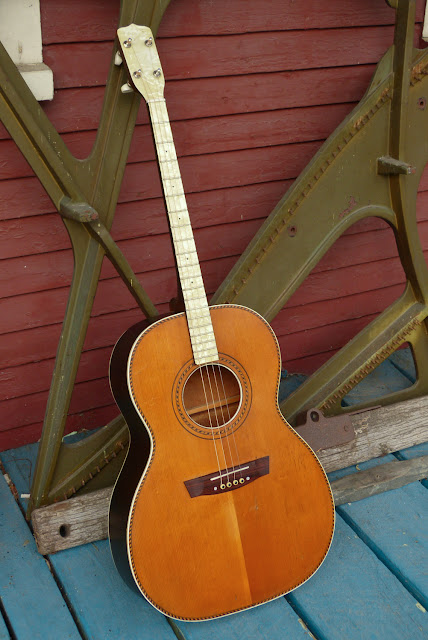1920s Oscar Schmidt-made Stella 00-Size Tenor Guitar
00-size tenors (14" on the lower bout) are pretty rare from the late-20s/early-30s period, and 14-fret necks are even rarer. To see it on an old pearloid-board Stella with the more-desirable "rope" trim is even better! A customer of mine sent me some photos of this and asked me, "is this a good deal?" Yes, of course, a thousand-times over!
He brought it in after scooping it up and I finished it as part of a batch with another instrument of his (to be seen as soon as new tuners arrive). Work included a neck reset, some crack and seam repairs, a refret and fret level/dress (more on that, later), new bone nut and saddle, vintage pins, and a set of Waverly 4:1 geared banjo tuners to replace the god-awful Champion friction pegs that were on it (the standard-issue Schmidt-supplied friction tuner).
After work it's punchy, sustained and proud in the same way that KTG-14s are, though with a bit more lower-mids rumble and a creamier treble. It has a 22 3/4" scale (similar to Gibson tenors), 1 1/8" nut width, and plays on-the-dot at 1/16" at the 12th fret. I've strung it up "octave mandolin" or "Celtic" style GDAE low to high with gauges 40w, 30w, 18w, 12.
I've grown very familiar with pearloid-board necks over the years, and just like on this other Stella, the solve for a bit of warp in the neck can't be to plane it level and refret in the traditional manner because then your celluloid gets ruined. What I do, instead, is install bigger frets and then level the top of them and dress them up.
My replacement rosewood bridge (the original was split in several places) is a bit bigger and, while not at all like the small rectangular original, gives that funky Knutsen-ish 20s vibe that Schmidt picked-up on some of the time. Another benefit is that the original bridge plate/brace was installed a bit too-far rear and the new bridge puts the bridge pins in a better location. The pins are old 1930s ones.
The ivoroid-buttoned, Waverly pegs are a ginormous upgrade and keep the instrument "tenor guitar-looking" rather than "guitar-looking" as it might've turned-out with right-angle tuners.
There's a repaired crack at the side and, as you can see, the finish has done the alligator, checking, and scuffing that is so typical of Schmidt products. These rarely, if ever, stay clean.
As you can see, there's some saddle, and considering that when this was finished it was super-hot and 90%+ humidity, I think it'll actually need to be shimmed up a bit in winter.



















Comments